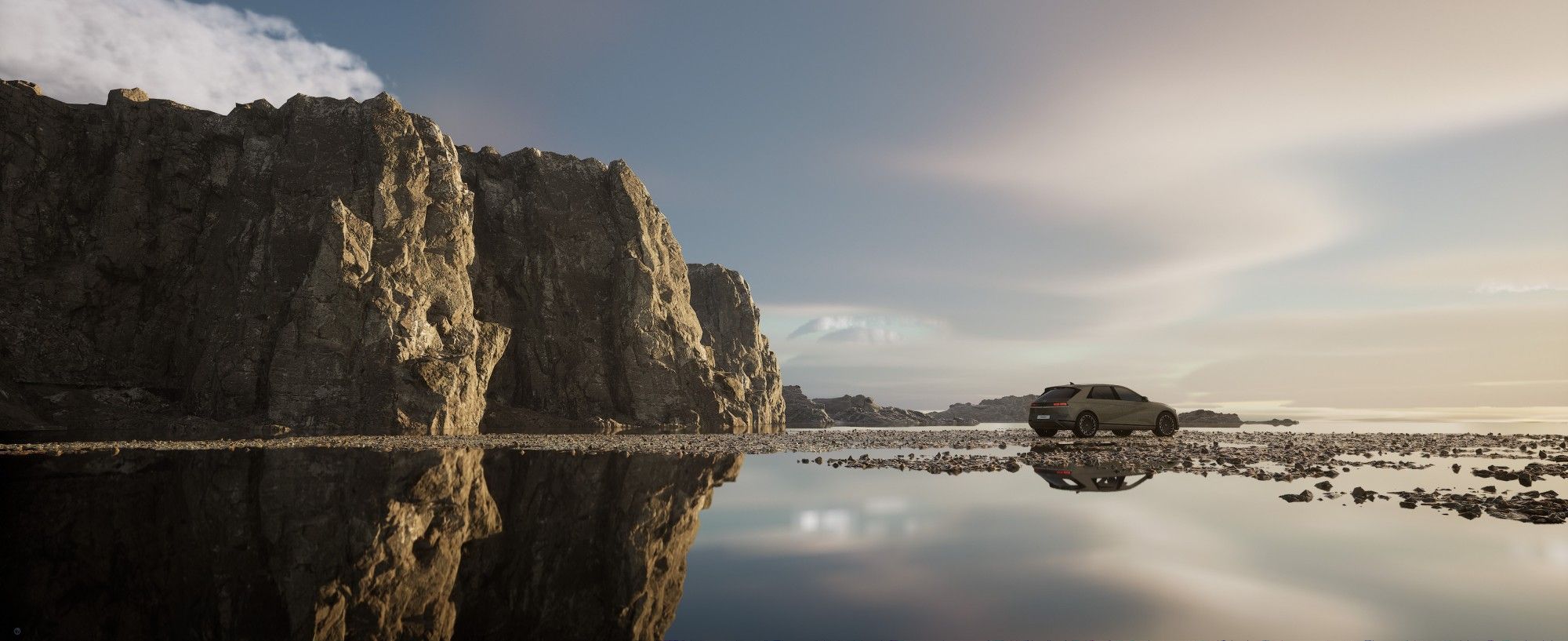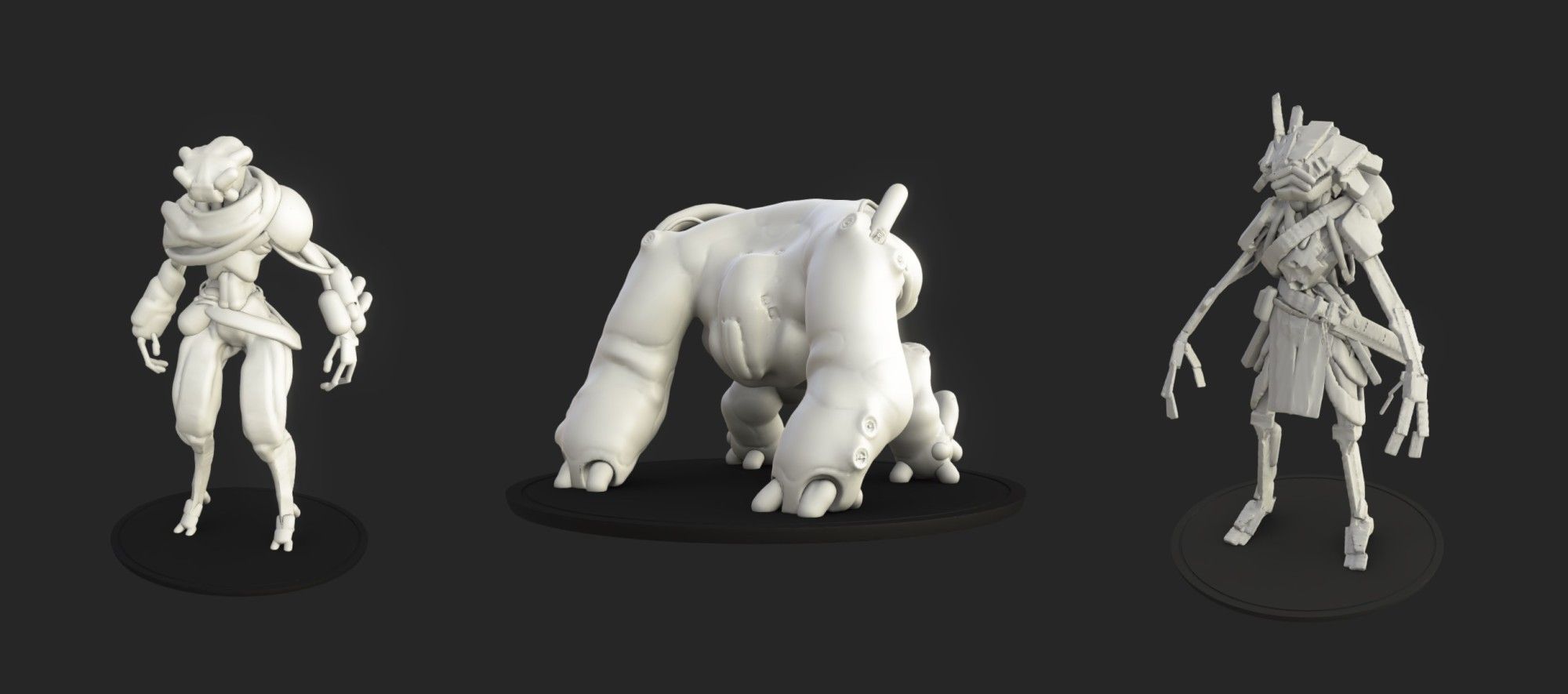One of the most frequent requests after the launch of Procreate 5.2 was, ‘Where can I download that sweet mech from the launch video?’ The mech in question was commissioned from Stéphane Bourez, creative technologist and 2D / 3D artist, who also recently appeared at Playgrounds Blend to share his 3D workflow in Procreate with the world. While the mech was never intended for download, we did sit down with Stéphane early one morning before work to discuss his new life in France, his workflow and gain some insight about how to go about making your own amazing 3D objects to paint in Procreate.
Stéphane is, by his own admission, not a natural morning person. Having recently moved to France from the UK to start his own company, he’s trying to embrace the advantages early starts bring. “I quite like the favors of the morning. You can hear the world waking up around you… and by the time everybody is about and you have all these different sources of distraction, you already have momentum. I think that's a great help.”
Every little bit helps, especially when you are as in demand as Stéphane is. “I’ve been very busy. I work with an advertising company called Collective London focusing on using Unreal Engine. It's a realtime 3D technology mainly for video games. I'm trying to push it in terms of being a pipeline for advertising, because it's a wonderful tool.”
Unreal Engine is continuing to push its photorealism capabilities in realtime. So we're really trying to convert our clients to these kind of pipelines and workflows.
“We show clients what’s possible through projects we’ve created for ourselves. We've done a VR game in the past, which was all done with Unreal Engine. And a prototype for a mobile game to encourage youngsters to go out instead of staying at home.”
Being a 3D obsessive since his early days working in the gaming industry, Stéphane continues to explore 3D tools even in his down time. Coincidentally, one of these mirrored a feature Procreate was working on for our latest release. “Funnily enough… I was trying to code a tool that allows me to light products using Blueprints – a coding environment in Unreal Engine. One of its main purposes was also to navigate around a product using either touch or the mouse. When the Procreate 5.2 alpha was released, for the first time you could rotate around objects and place lights. It was interesting to see the parallels. Of course, my code wasn’t as polished as yours! Until you try to develop a 3D navigation tool from scratch, you don’t realize how subtle and vastly complicated it can be. In Procreate, you’ve managed to make so many advanced tasks feel simple and natural to perform, with a clever use of gestures and UI. This, should be called The Invisible Art!”

Stéphane’s talents don’t stop with 3D technology. Being an accomplished portrait painter, 3D sci-fi and fantasy artist and public speaker, we asked if there was a common theme to all of his creative endeavors, “I've learned a lot from graphic designers, and from copywriters, and from all the creative department as well. They are completely different animals and the way they're thinking is completely different. I think when you work very closely with creatives, you kind of absorb all sorts of things. It's kind of like mixing sands. At least in small teams, it's nicely organic like that.”
“I've learned a lot about storytelling in this industry as well because of the people, the way they craft messages and communication. My focus here is playing with toys and trying to make sense out of them, and how we can use them with our clients for their projects.”
How does one explain this to clients in a simple way when it comes wrapped in such complex, cutting edge 3D technology? “I think this is best when you keep it simple, I just use traditional references. What we're doing is storytelling. We use new generation tools, but it is fundamentally to apply them to storytelling.”
Imagine a theater play, and you have the background elements that slide up and down very quickly, and it's ever changing.’ This is how I explain generative arts to a person who doesn't know anything about computers.
Before relocating from the UK where he had resided for over a decade, Stéphane, like many others around the world, found that COVID-19 made him reprioritize where he wanted to work. “I figured, ‘I could work from France to be close to my family, and enjoy a different life style, and still come back to the UK often so, fine, let's do that.’ To be away from a big city and to have the ocean nearby, that's nice. That's a good change as well, so I very much enjoyed it.”
Stéphane’s move meant having to set up his own company but he has been able to keep the partnership with Collective intact, “I still have these very good friends for whom I work full time, with an exclusive arrangement.” Luckily for Procreate, Stéphane still had time to take on the odd commission despite his extensive list of projects, and was happy to share his thoughts about 3D model painting coming to Procreate.
“There was a beautiful serendipity there. I was really surprised. There are two worlds that are very dear to me, which is the world of illustration and painting and traditional drawing, and the world of 3D. And Procreate combined both all in the elegance of the iPad format.”

"When I received the email I was literally like, ‘Yes!’ And yet, I had a little bit of defiance as well, thinking, ‘How on earth? Let's see. Well, okay here goes.’ But I was super happy, because previously with Procreate, I was doing 2D commissions and now I’m doing more and more 3D. So I thought, ‘That's a real shame, as we're going to have less and less reason to work together.’ And now, ‘here we go!’”
“At first I thought, ‘Wow, this is very ambitious.’ Because it's not just one little addition, it's an entire whole new world. And I know how particular and specific you are on keeping things super simple in Procreate. I thought, ‘How on Earth are they going to pull this off?’”Stéphane was initially involved using early versions of Procreate 5.2 to create his commissions. This gave him a unique insight into how the 3D model paint feature developed as time went on. “The beauty of that is I saw the app grow, and the functionality starting to kick in, and to have more and more features. Then the tools started getting streamlined, and there was the arrival of new tools. And it starts to build and build, until all of the minimum viable project was there together for the release.”
It was nice to see that little baby grow. And I'm glad to have a little stone of mine on that tide. I'm glad I've been part of that.
Stéphane’s mech and alien cat featured heavily in the Procreate 5.2 launch and made a big splash online. Being one of the first professionals to develop a workflow for creating 3D objects and bringing them into Procreate to paint, we had to know how Stéphane pulled it off to such great effect. “The way I structure my workflow with you guys has always been starting out with a series of sketches first. Not detailed though, just loose ideas. This time I thought because it was going to be a 3D object, the sketches should already be in 3D. I took the gamble of having one version more polished right from the first round.”
“There are tools to be able to literally use a form of virtual clay, which is called voxel sculpting. First, I used these voxel sketches, and then we continued to refine it. Once we had a shape we were happy to work on together, then I started to transform that ‘sketch' into a more polished 3D object.”
"From there, I've used a bit of Shapr3D just because I thought, ‘Let's try this guy out.’ It took a bit more time, but that was more of an investment on my part because I wanted to try to use it. And once I was done with that and you were happy with how the piece was coming together, I imported it into Blender to do all the UV and wrapping and the smaller details so that it would be ready to be painted with the UV maps. That's pretty much the pipeline for the 3D object.”
The final step was taking his 3D objects into Procreate to paint where Stéphane’s work was spectacular. We asked if he has ever contemplated going one step further and exporting his painted pieces to take back into other 3D software like Unreal? “I really want to, I want to see that in my portfolio.”
“And Unreal are pushing their USDZ pipelines as well. USDZ is just a zipped USD, so I'm pretty sure that would be great. A USD bridge between who knows? But you could paint in Procreate, press a button and it appears on your computer screen, be it Mac or PC because Unreal is platform agnostic.”
With 3D model painting off to a strong start in Procreate, what tools have capture Stéphane's imagination? “The transform tool is very cool, especially the projection tool. It was just a joy to use at 120 FPS on a touch screen. Just to stretch a bit of pattern or texture across the model, and see it grow and slide on it and evolve. You're like, ‘Hey, that's a cool tool. It's giving me 120 propositions in a second. Every move I make there is a new design there.’ This is powerful, because when you do it on the computer it's not as fluid, you don't have that fluid multi-touch feeling.”
“I have to say the brush engine is still, I think, the strength of Procreate. It all is really revolving around that. The brush engine to me is the most powerful thing. And you keep taking care of it, and streamlining it, and making it better and better all the time.”
I think it is by far the best brush engine I've seen, period. I would say the brush engine and the transform tools, definitely to me are the most impressive tools.
Speaking of making Procreate’s 3D model painting better in the future, Stéphane had a few ideas for us. “It would be great for you to continue to refine how Procreate handles the rotation around objects. I think the overall way Procreate handles the object and the spin is great, but it can be streamlined.“I think it’s going to become a powerful tool, even for professionals. I can’t wait to see it, because this is just the beginning. With augmented reality starting to take off too, I can’t wait to see what we’re going to be able to do in the future.”
For anyone not sure if 3D, or any new creative technology, is for them Stéphane gives us a great way to look at what all creative tools are for: “Storytelling, drawing, and expressing yourself.” So if you're wanting to jump in, try beginning with Procreate’s 3D model pack as a starter, and see where the journey takes you.
If you would like to discover more about Stéphane Bourez you can check out his Artstation and Instagram. Or watch his recent Procreate Live Draw where he takes us through how he painted his incredible 3D mech.